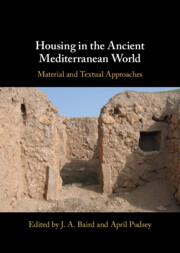Book contents
- Housing in the Ancient Mediterranean World
- Housing in the Ancient Mediterranean World
- Copyright page
- Contents
- Figures
- Tables
- Contributors
- Acknowledgements
- Introduction
- 1 Kinship ‘In the Halls’
- 2 Domesticating the Ancient House
- 3 Mind the Gap
- 4 A Family Affair
- 5 Textiles in Alkestis’ thalamos
- 6 Architectural Rhetoric and the Rhetoric of Architecture
- 7 The Reconstruction of an Agricultural Landscape
- 8 Mudbricks and Papyri from the Desert Sand
- 9 Housing and Community
- 10 The Elusive vestibulum
- 11 Living in the Liminal
- 12 Experiencing Sense, Place and Space in the Roman Villa
- 13 Houses and Time
- 14 Spaces of Desire
- 15 A Response: ‘Using the Material and Written Sources’ Revisited
- Index
- References
2 - Domesticating the Ancient House
The Archaeology of a False Analogy
Published online by Cambridge University Press: 08 July 2022
- Housing in the Ancient Mediterranean World
- Housing in the Ancient Mediterranean World
- Copyright page
- Contents
- Figures
- Tables
- Contributors
- Acknowledgements
- Introduction
- 1 Kinship ‘In the Halls’
- 2 Domesticating the Ancient House
- 3 Mind the Gap
- 4 A Family Affair
- 5 Textiles in Alkestis’ thalamos
- 6 Architectural Rhetoric and the Rhetoric of Architecture
- 7 The Reconstruction of an Agricultural Landscape
- 8 Mudbricks and Papyri from the Desert Sand
- 9 Housing and Community
- 10 The Elusive vestibulum
- 11 Living in the Liminal
- 12 Experiencing Sense, Place and Space in the Roman Villa
- 13 Houses and Time
- 14 Spaces of Desire
- 15 A Response: ‘Using the Material and Written Sources’ Revisited
- Index
- References
Summary
Historians and archaeologists habitually describe ancient households as domestic contexts without explaining what the neologism means or how it relates to Greek and Roman household organization. This chapter interrogates the disciplinary usage of the term by exploring how the category of the ‘domestic’ has evolved at the intersection between representations of private life in modern museum galleries and Athenian vase-painting, on the one hand, and normative evaluations of significant and insignificant human action, on the other. A survey of three museum displays (in the Museo Ercolanese, the British Museum and the Getty Villa) reveals a shift in how the domestic sphere was defined, substituting for the models provided by the architecture of European noble estates the home of the Victorian citizen, with its gendered distinctions between private and public. To understand this shift the discussion extends from the factors of industrialization and middle-class consumption foregrounded in social histories of the 19th century to the contemporaneous discovery of non-mythological scenes in Athenian vase-painting as depictions of ‘everyday life’.
Keywords
- Type
- Chapter
- Information
- Housing in the Ancient Mediterranean WorldMaterial and Textual Approaches, pp. 68 - 95Publisher: Cambridge University PressPrint publication year: 2022
References
- 1
- Cited by



